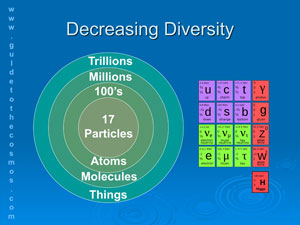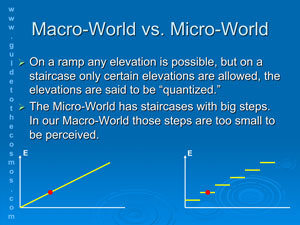|
|

|
As
we peer deeper and deeper into nature we see less and less diversity.
The Macro-World (everything we can see by eye) explodes with diversity
— every galaxy, every person, and even every snowflake is unique. But
at a smaller scale, everything
is made of molecules, which are far less diverse, and these are made of
atoms, of which there are only
hundreds of different types.
|
|
The
Micro-World of Quantum Mechanics seems bizarre due to its small size
and “quantization.” The Micro-World is dominated by “staircases” that,
for example, allow electrons only a few orbits in atoms. At this scale,
the steps have dramatic consequences. Since we are vastly larger than
electrons, we don’t perceive the steps and instead see continuous ramps.
|

|
|

|
Before
Einstein, physicists were sure particles and waves were entirely
different, separated by a great wall, with light being a wave. Einstein
showed that light was both a particle and a wave, leading to
particle-wave duality, the realization that everything is both a
particle and a wave.
|
|
On
the upper left are interference fringes, a hallmark of wave behavior,
produced by light passing through two slits in a barrier. On the right,
light was replaced by an electron beam. Below we see individual dots
where 200 electrons hit the detector, proving electrons are particles.
Above, after 140,000 electron hits, we see interference fringes proving
electrons are also waves.
|

|
|

|
A sealed box
contains a cat and a bottle of poison gas that
opens at a random time. The question is: “Can the cat be both alive and
dead.” Bohr said yes, until we open the box and look inside. Einstein
said that was crazy. In the Micro-World, Bohr is correct. In the
Macro-World of real cats, my money’s on Einstein.
|
|
|